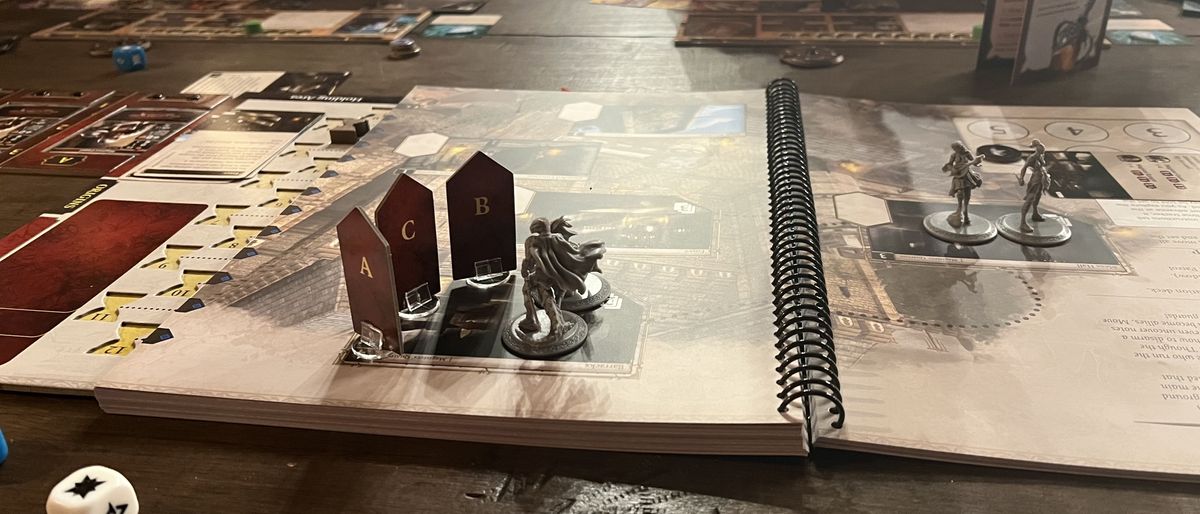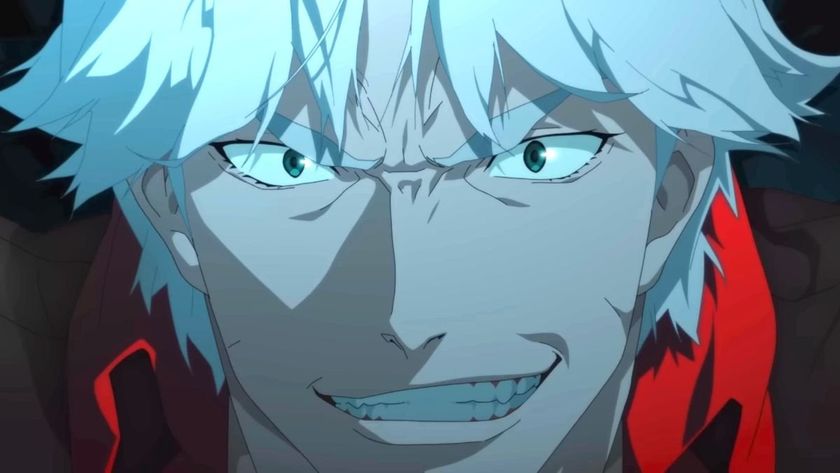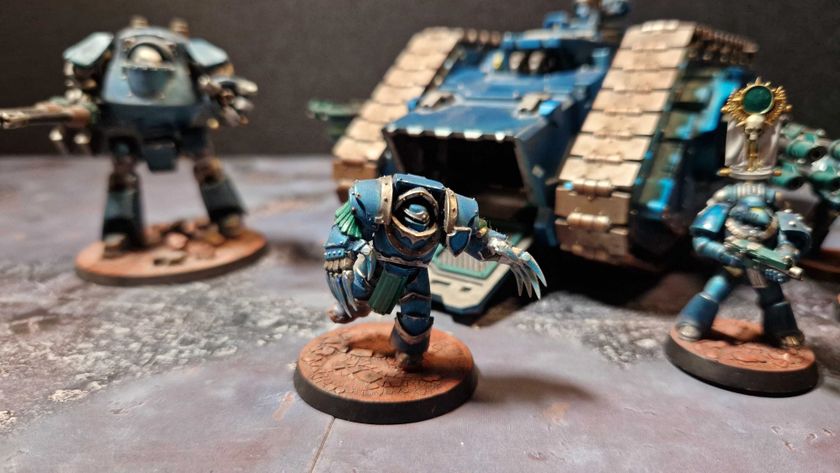12DOVE Verdict
This sprawling RPG adventure is ambitious, even by today's big-box standards where games come with mountains of models, components, and scenarios. Thanks to a novel combat system and an impressively replayable story with multiple branches, Divinity Original Sin: The Board Game certainly earns its keep. However, it doesn't always live up to the competition. Poor component choices, combat that can drag, and punishing difficulty you can't always prepare for when exploring keep it from reaching that peak.
Pros
- +
Unusual combat system that relies on cooldown tracks and wide palette of possible actions
- +
Levelling up gives you lots of options and the chance to plan for combos
- +
Branching storyline is both engaging and replayable, with lots of variety
Cons
- -
Too little strategy and too much pressure when it comes to map exploration
- -
Combat is very time-consuming and can feel repetitive
- -
Questionable component choices and confusing rulebook
Why you can trust 12DOVE
Divinity Original Sin: The Board Game has a lot to live up to.
Divinity, and its various spin-offs and prequels, have become a juggernaut of computer RPGs. They’ve sold millions of copies across formats and have been lavished with critical and fan praise alike for their storytelling and tactical isometric combat. And as the series is founded on that famous combat engine, a board game is only a step away. Now Divinity Original Sin: The Board Game is here, and it’s an ambitious undertaking to say the least. A full campaign of adventure in the lands of Rivellon await, only this time on your tabletop rather than your screen.
Does Divinity reach the heights of its competitors, often seen as some of the best board games? Not quite, but it has a very good go – its variety, world-building, and narrative are way ahead of its peers.
Divinity Original Sin: The Board Game features & design
| Price | $160 / £130 |
| Ages | 14+ |
| Players | 1 - 4 |
| Complexity | High |
| Genre | Fantasy |
| Lasts | 45 - 120mins per scenario |
| Publisher | Larian Studios |
| Play if you like | Gloomhaven, Sleeping Gods, the video game series |
- Fantasy RPG with expansive world and narrative
- Scenarios are split into exploration, combat, and rest rounds
- Differentiates itself with a cooldown slider system
This game can loosely be defined as a dungeon-crawler, and you'll be levelling up your heroes while battling through a choose-your-path adventure. In other words, anyone that's played Gloomhaven (or spin-offs like Gloomhaven: Jaws of the Lion) will feel right at home.
The narrative should also be familiar, as it's an adaptation of the Divinity: Original Sin 2 story. But not beat for beat – if anything, it's more like a remix than a retelling. There are new quests, foes, characters, and more for players to experience as they explore the fantasy world of Rivellon.
That makes for a chunky box full of components and story requiring some commitment, so consider yourself warned if you're low on time or space.
This means there's a lot to get through, and Divinity Original Sin: The Board Game makes a lot of its tutorial mode which promises to walk you through the basics of play. You'll still have a fair amount of reading to do, and you'll also need to dig out components beneath a big label that specifically says you don’t need anything under it to start, but other than that, the tutorial fulfils its promise well. It starts out by taking you through setup, in which you’ll choose a character – referred to as Origins – from a starting selection of four, with preselected skills and equipment. (There are another six characters in the box to pick from, once you’re more experienced.) Each player then gets a board to lay out their character card, equipment, and inventory, and to track their cooldowns and action points.

Those cooldowns and action points are core to the combat gameplay. On a player’s turn, they have a pool of action points, which they can spend on taking actions with equipped items or to use skills. Non-consumable items like weapons can be used as many times in a round as you like, but most skills go on the cooldown track at a space specified on the card. They slide down one space each round until they fall off the end, at which point you can use them again. In some cases, this just stops you spamming the skill over and over, but other skills have an ongoing effect while they’re on the cooldown track, such as invisibility.
Enemies can be fast or slow, on the other hand, and they roll a die to determine how they’ll choose their target. Combat works the same for both Origins and foes, though, and it involves rolling a selection of dice. There are three colors of dice, each of which is more likely to roll hits and/or special effects which are specified on the attack card, often inflicting statuses such as blind or bleeding, which also slide down the cooldown track. Incoming damage is reduced by armour as you'd expect, with different values for physical and magical attacks, and the remainder is taken off the target’s health.

Each scenario is represented by pages in the colossal Divine Atlas, which has interconnected areas that characters and enemies can move between. Most locations have cards to dig out, text to read, actions to take, and dice to roll, which may result in a surprise when you flip the card to be told how your picks and dice rolls play out.
Once the map is free of enemies, your party collectively decides whether to take rest or exploration rounds until such time as more foes spawn: this is a cooperative board game, after all. Rest rounds are straightforward, allowing you to heal or donate health to fallen characters to bring them back into the game. Meanwhile, exploration rounds let you move around the map.
Whatever kind of round you have, once it’s over a timer ticks down on a track. All the scenarios have a time limit, which generally results in negative consequences should you exceed it before finding a way to exit the map. Whatever way things resolve, you’ll then be instructed on what page of the Divine Atlas to go to for the next scenario. In between games, you can purchase more equipment at the merchant and, sometimes, level up your character to gain more skills and better stats.
While the core gameplay loop as outlined in the tutorial isn't hugely hard to get to grips with, there's a lot of detail on the cards and edge cases in the rules you'll eventually need to get to grips with. While it's all in the rulebook somewhere, it's often not straightforward to find clarifications when you need them. It’s also worth noting that, while the art and miniatures are good quality, the game is oddly threadbare when it comes to showcasing enemies, giving you only plain, letter-marked standees to indicate foes. You can, as you might expect, buy miniature expansions to represent them instead.
Divinity Original Sin: The Board Game gameplay

- Focuses on identifying combos between party powers and enemy weaknesses
- This makes levelling up lots of fun as you explore new synergies
- Lots of narrative paths to explore, but light on detail and ongoing strategy
The tutorial dumps you into combat right away, and after you’ve played a few more scenarios, it becomes clear that combat is the game’s focus, including epic boss characters that have their own booklet to track stats and damage. Nothing wrong with that in itself, but the small point to point map layouts of the game don’t really lend themselves to anything like manoeuvre. Missile weapons exist and can play a part, as do terrain effects, but the real engine of interest when it comes to taking down the bad guys is working out what you, as a party, can achieve together in terms of combining your own powers and exploiting the weaknesses of the villains.
Take Ifan, one of the four tutorial characters. On the face of it, he’s an archetypal warrior with a big sword, one that does extra damage if the target has at least one condition. But he’s also got access to necromantic magic. One of his spells can give the target the 'Bleeding' condition, which combos well with the sword and chips damage each turn it’s on the cooldown track. But that spell, in turn, deals extra damage if the target has the 'Poisoned' condition. Another starting character, the lich-like Fane, has a poison dart spell that does what the title suggests, and poison also chips damage while on the cooldown track. So these two characters combo really well together.
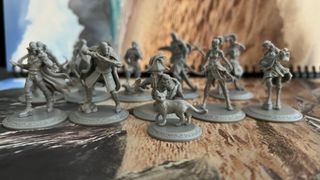
There are plenty of extras on offer alongside the core game. Nightmare Dungeon adds a rogue-like adventure mode, Nemesis lets characters make an infernal pact in new story content, and Haunted Keep provides a classic dungeon crawl. You can get a Miniatures Upgrade box as well, allowing you to use models of the game's foes.
And it’s these kinds of synergies that make Divinity Original Sin: The Board Game interesting to play. Not only in terms of selecting your starting character, but also every time you level up, gain new skills, find and swap items on your adventures, or buy them from the merchant. Levelling up isn’t slow, but the repetitive nature of the card-driven combat may leave you wishing it were faster still, just so you can get some new powers to play with. Still, whenever it happens, it’s very engaging to look through the various options and try to work out what will mesh well together.
You’ll need to develop a good eye for this, because the game is also pretty tough. Starting Origins mostly have health in the single-figures, and it’s not hard for early enemies to do that much damage in a single hit if they roll some lucky dice. Your armor will help keep you alive, as will some health regeneration spells and items along with rest turns, but the challenge will keep you on your toes. Be prepared to lose more combats and scenarios than you might be expecting, not least because of the way the time pressure creeps up as you agonize over whether to spend precious turns on resting or risking one more location on the map.
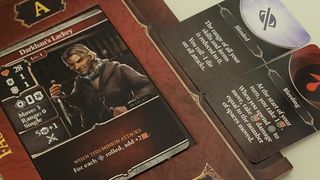
As fun as these decisions are, the game sits in an uneasy place as regards giving you narrative versus strategy. The Divine Atlas is big, and there are a lot of branching routes through. So many, in fact, that a second playthrough will likely unfold in a very different manner. But the actual storytelling is light, and will certainly engage fans of the video game a lot more than it will casual players.
When it comes to moving round the game’s location, you also get very little warning about what might be ahead. That adds to the tension, but it’s frustrating from a decision-making point of view. You have no idea whether you’re about to walk into an ambush or a treasure chest, or how much time any encounter might take, and these factors can easily tip you into losing a scenario or rushing out and missing fun details.
Should you buy Divinity Original Sin: The Board Game?
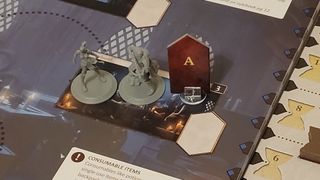
While there’s plenty to enjoy here, the biggest barrier to this game is simply the competition. This is a huge, many-hour, replayable campaign adventure and represents an equally huge time commitment if you want to get the most out of it. And in terms of huge, many-hour, replayable campaign adventures it’s up against Gloomhaven and its sequels (widely acclaimed as some of the top board games for adults of all time) and also the excellent and similarly lauded Sleeping Gods. Those are some awfully big boots to fill and some awfully long play-hours to invest and, whatever its merits, Divinity Original Sin: The Board Game can’t come close.
That said, if you’re a fan of the fantastic video game series – and there are many – you may well find that the world-building, story-telling, and sheer variety on offer here swings it in front of the mechanical attractions of its peers.
Buy it if...
✅ You love campaign-style adventure board games
If you're a fan of sprawling RPG adventures, this will be like catnip for you. It's stuffed with content and should keep you busy for a long while to come.
✅ You’re a big Divinity: Original Sin fan
It goes without saying that fans of the franchise will get the most out of this one. It does its inspiration justice.
Don't buy it if...
❌ You prefer strategy to tactics or narrative in your board games
There are similar games with deeper combat mechanics on shelves right now, so you might be better served by them if that's what you want.
❌ You’re not willing to sink lots of time into a single title
This is a truly massive commitment both in terms of time and room, so give it a miss if you're short on either.
How we tested Divinity Original Sin: The Board Game
Disclaimer
This review was conducted with a sample provided by the publisher.
Our experienced reviewer made sure they played this game multiple times to get a comprehensive overview of how its mechanics worked, and to see how the experience changed with different player-counts. They also focused on the game's systems in relation to similar products, comparing and contrasting the two.
You can learn more about our process via the following review policy. Alternatively, you can check out the following guide on how we test board games.
Matt is a freelance writer specialising in board games and tabletop. With over a decade of reviews under his belt, he has racked up credits including IGN, Dicebreaker, T3, and The Guardian.
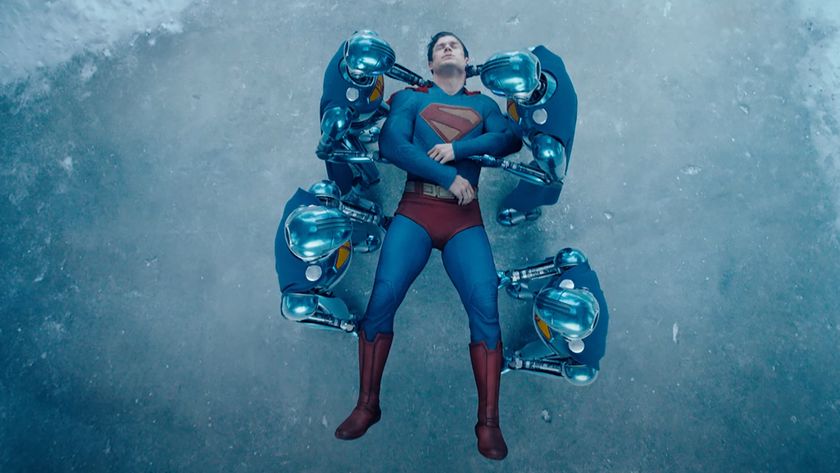
Superman goes full sci-fi in DC's epic CinemaCon footage, showcasing a bloodied Man of Steel rising again

Switch 2 analyst says the $450 price tag is "relatively reasonable" compared to the $700 PS5 Pro and $550 portable PCs
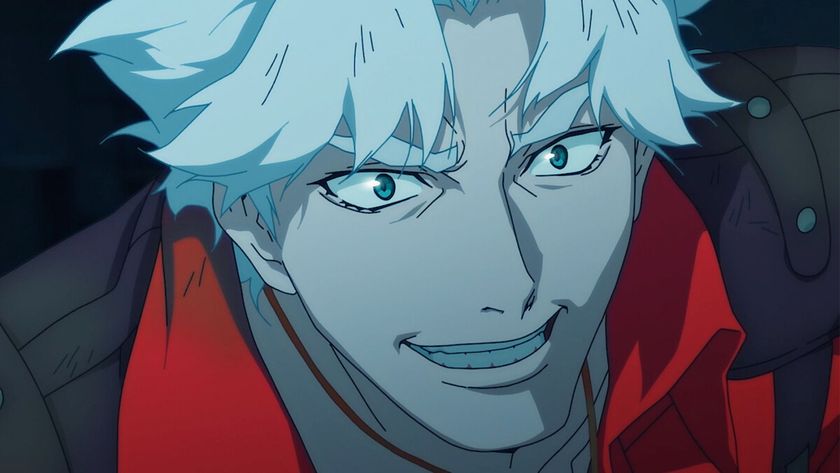
Devil May Cry Nero actor didn't realize he was auditioning to play Dante in the new Netflix series until the show's producer said he wrote the lead role just for him: "A different weight on my shoulders"
